Climbing a mountain isn’t for the faint of heart. It takes skill, determination and a high fitness level to literally stand on top of a mountain and punch your fists in the air. But people do it every day. Heck, Mount Everest is getting so crowded, there’s a line at the summit to take a picture during the mountain climbing season.
There’s a particular attraction to mountains that you can’t deny, whether you want to make the vigorous summit to their tops or take in their views from a distance. We gathered data from Visual Capitalist to help us learn about the 35 tallest mountains in the world — and the fascinating stories of those who risked their lives climbing them.
35. Mount Ararat
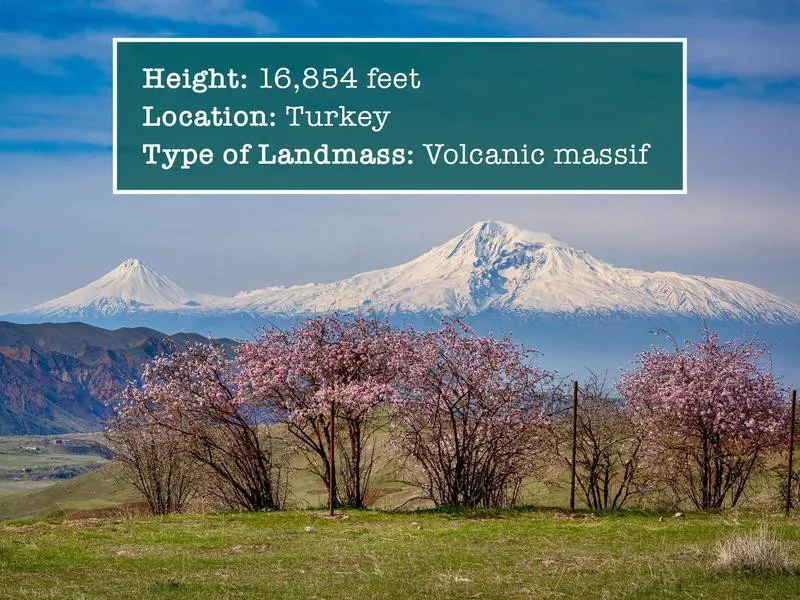
Getty Images
What Its Name Means: It’s thought to come from Sanskrit, meaning “holy ground” or from the Turkish meaning “pain” or “sorrow.”
* Most of these enormous landforms (with data from Visual Capitalist) aren’t just mountains but are also massifs and volcanoes. A massif is a compact group of mountains, so it looks more extensive than a single, steep mountain. And, of course, a volcano spews molten hot lava and volcanic ash from its peak when disturbed.
What Sets It Apart
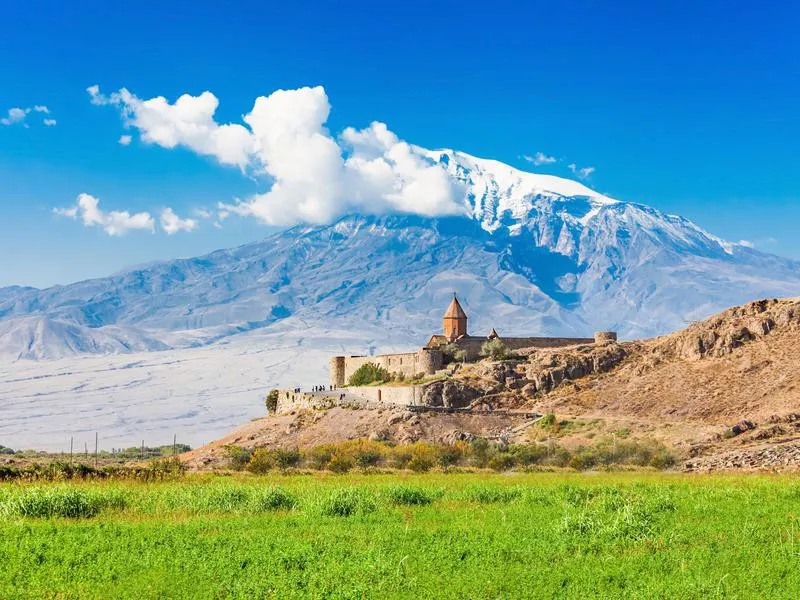
Getty Images
Mount Ararat is a 16,854-foot, snow-capped volcano in Turkey. Don’t worry, it’s dormant, so people can hike to the top, where you can overlook Turkey, Iran and Armenia. Mount Ararat has two peaks cleverly named Great Ararat and Little Ararat. The summits are about 7 miles apart.
Legend has it that Noah’s Ark (yes, the biblical story with all the animals) ended its journey on Mount Ararat as it says in Genesis 8:4 that “the Ark landed on the mountains of Ararat on the 150th day of the Flood.” The wreckage of the ancient wooden vessel has yet to be found.
34. Mawenzi
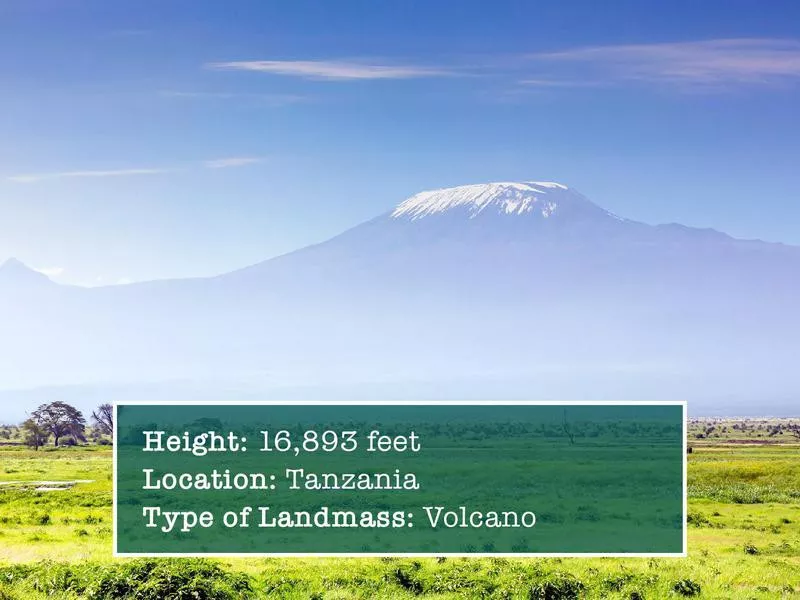
Getty Images
What Its Name Means: It translates to “the crumpled, jagged, broken one.”
What Sets It Apart
Mawenzi is also known as Kilimanjaro’s second summit. It’s the third tallest mountain in Africa and rather daunting in appearance with a steep, spikey and rigid peak. Mawenzi is dangerous to climb, so it closed in the early 2000s because of too many fatalities.
The mountain is now open to climbers again, but you’ll need to have all the necessary qualifications to start your journey. Plus, a lot of courage.
33. King Peak
What Its Name Means: It’s named after William King, a Canadian surveyor, astronomer and civil servant.
What Sets It Apart
There are three King Peaks in the world: a summit in California, a peak in Utah and a volcano in Canada. We’re talking about the one in Canada. King Peak is a double peak, glacial volcano in the Yukon province. It has a demanding trail to the top that has climbers racing from 1,000 feet to 5,700 feet in 4 miles!
There are no fees or permits required to tackle this mountain, so it’s good practice for climbers before tackling the mighty Mount Logan just 10 miles away.
32. Mount Kenya
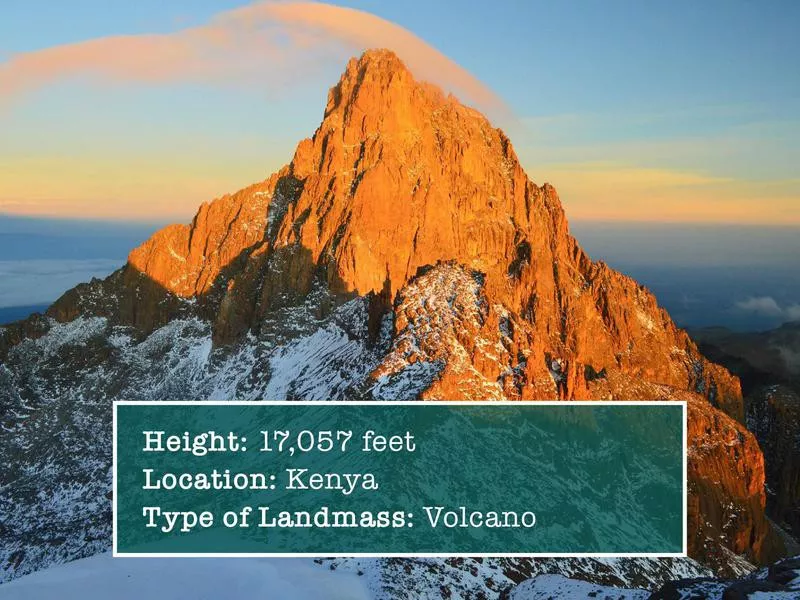
Getty Images
What Its Name Means: It comes from “kirinyaga,” which is Kikuyu for “place of the male ostrich,” thanks to its coloration.
What Sets It Apart
Mount Kenya is a versatile stratovolcano in Kenya. It has three peaks that range from medium to difficult to trek. The most popular peak for climbers is Point Lenana, as it’s the most doable and affordable (for those who like to hike, climb or scale mountains).
Mount Kenya is in Mount Kenya National Park, where there are plenty of other things to do, too, such as caving, camping, bird watching and spotting African wildlife.
31. Shkhara
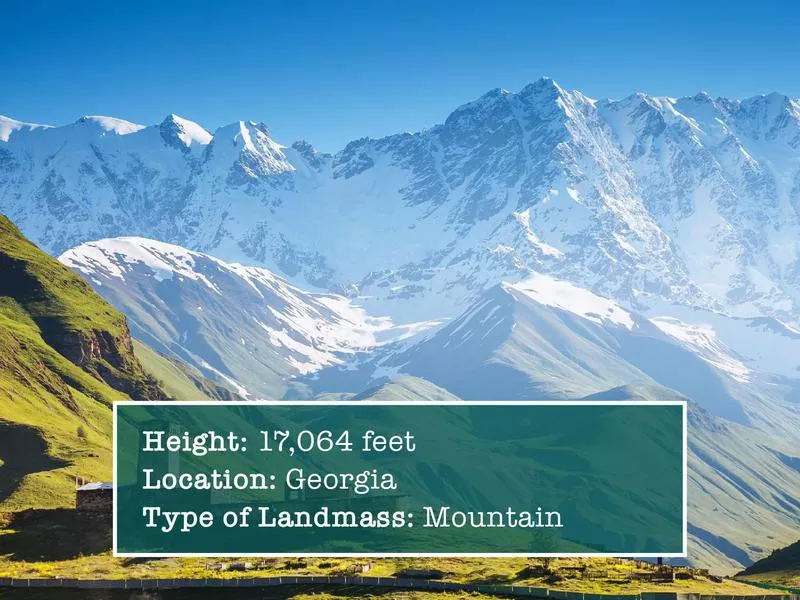
Getty Images
What Its Name Means: Unclear
What Sets It Apart
Shkhara is a tall, steep, glacial mountain in Georgia. It’s the anchor of the massif known as Bezengi Wall, which rises between Russia and Georgia. The top of the ridge is about 7 miles long, making it a big challenge for climbers.
Conquering Bezengi Wall is considered “Europe’s longest, most arduous and most committing expedition.” Well, at least it’s something to brag about.
30. Iztaccihuatl
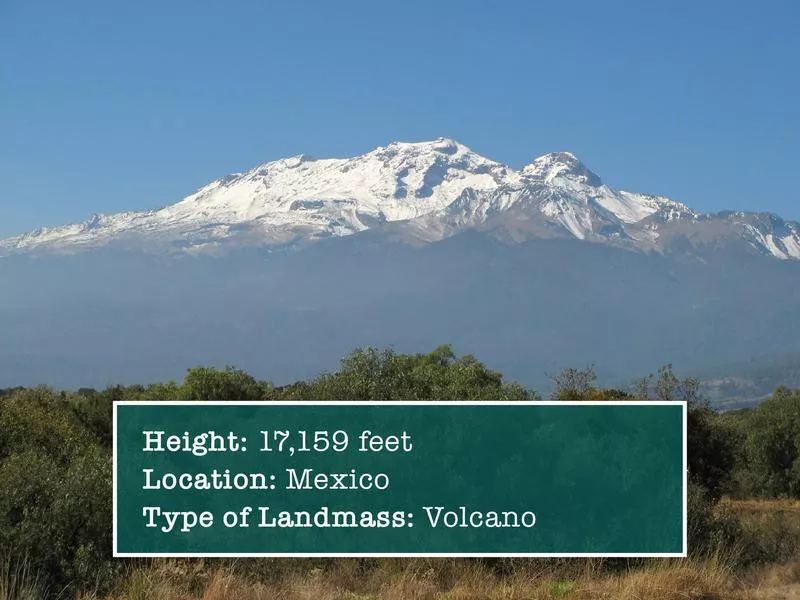
Getty Images
What Its Name Means: It’s Nahuatl for “white woman.”
What Sets It Apart
Iztaccihuatl (aka Ixta) has personality. If you view this volcano from the west or the east, you can see a sleeping lady lying on her back. OK, not a real one, but an outline formed by the ridges of the peaks. The north end is her head; the middle is her belly; the south end is her knees. She last erupted in 1868.
It’s a five- to eight-hour climb to the top of Iztaccihuatl, with the most significant challenge being the change in altitude. Ixta is in Iztaccihuatl-Popocatepetl National Park, where there is a diversity of habitats for wild animals.
29. Mount Lucania
What Its Name Means: It was named by the Duke of Abruzzi for the RMS Lucania, the ship that sailed from Liverpool, England, to New York in 1893.
What Sets It Apart
Mount Lucania will catch your eye, just as it did for the Duke of Abruzzi in 1897. When he stood on top of nearby Mount Saint Elias, he saw a massive mountain in the distance and named her Mount Lucania.
The first ascent of Mount Lucania was by the famous mountaineers Robert Bates and Bradford Washburn in 1937. A plane flew them to a glacier on the mountain, but when it landed, it got stuck in the soft snow. It took days for the plane to get out, and when the pilot took off, he told Bates and Washburn that he wouldn’t come back to pick them up. That meant a 70-mile trek down the mountain without maps.
28. Mount Foraker / Menlale
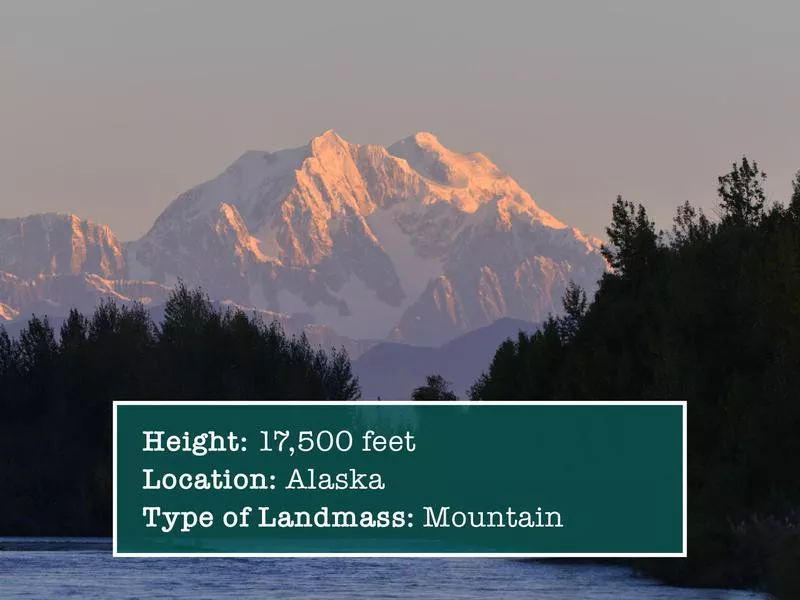
Getty Images
What Its Name Means: It’s named after Joseph B. Foraker, a senator from Ohio, while its Dena’ina name means “Denali’s wife.”
What Sets It Apart
Although it’s named after Joseph B. Foraker, a senator from Ohio, its Dena’ina name means “ Denali’s wife.” After all, it is the second tallest mountain in the central Alaska Range, with Denali being the tallest. The popular climbing trail up Mount Foraker is called Sultana Ridge.
Not many people hike Mount Foraker, as there is a 60-day waiting period after submitting registration forms to the park ranger, and it costs about $11,500 to climb. You can tell us if it’s worth the investment!
27. Popocatepetl
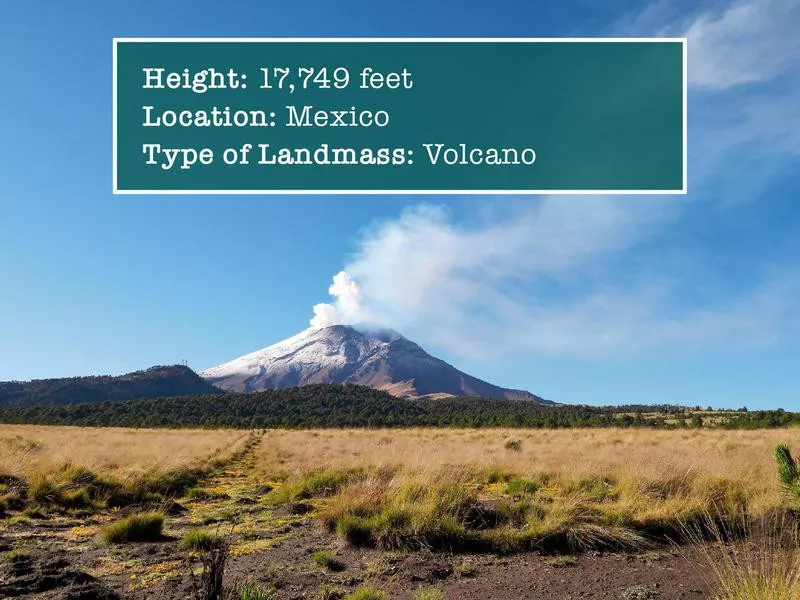
Getty Images
What Its Name Means: It comes from the Nahuatl for “smoking mountain.”
What Sets It Apart
Popocatepetl is an active volcano in Mexico. Remember the other volcano in Mexico called Iztaccihuatl? There’s a myth that these two volcanoes are lovers who had a tragic end. Popocatepetl exhibits explosive eruptions avenging his beloved’s death. He’s certainly temperamental, having erupted in 1994, 1996, 1997 and 2000.
This volcano is closed to climbers for obvious reasons, but you can still get a good photo of it from a distance. Santiago Xalitzintla is the closest town to the summit of the heartbroken Popocatepetl.
26. Mount Saint Elias
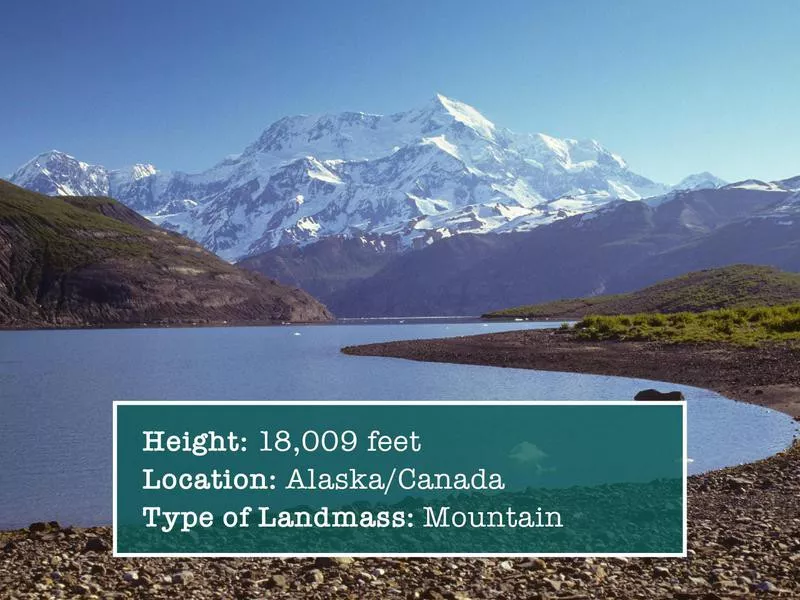
Getty Images
What Its Name Means: It’s named after Cape Saint Elias, although its Tlingit name means “mountain behind Icy Bay.”
What Sets It Apart
Mount Saint Elias is the second tallest mountain in the United States and Canada. It sits on the border of Alaska and challenges climbers to embark on a world-class expedition to the summit. A Mount Saint Elias expedition takes about three weeks to complete and about $10,000 to $20,000 in fees and permits.
Plus, it’s only open to the most experienced climbers in the world. Mount Saint Elias has only been scaled about 50 times since the first expedition in 1897.
25. Pico de Orizaba
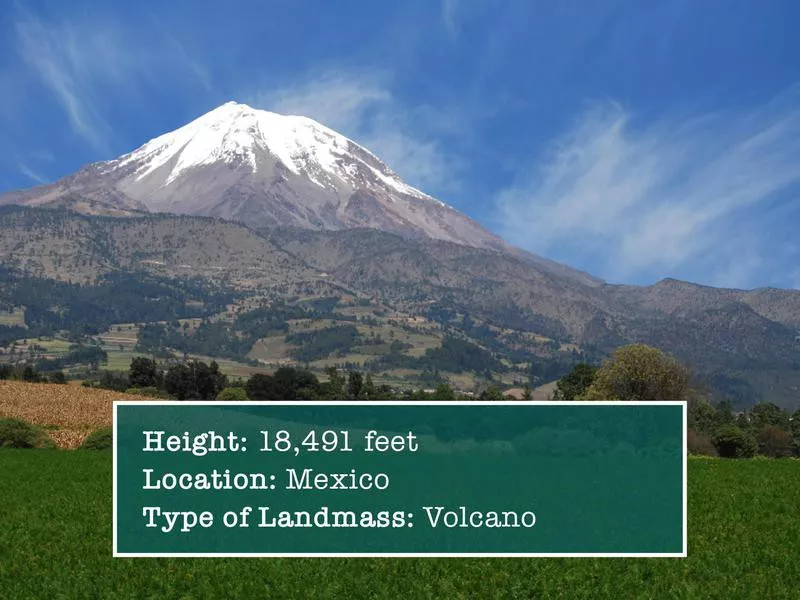
Getty Images
What Its Name Means: It’s named after the valley and city it overlooks. Its Nahuatl name means “star mountain” because the snow-covered peak can be seen year-round throughout the region.
What Sets It Apart
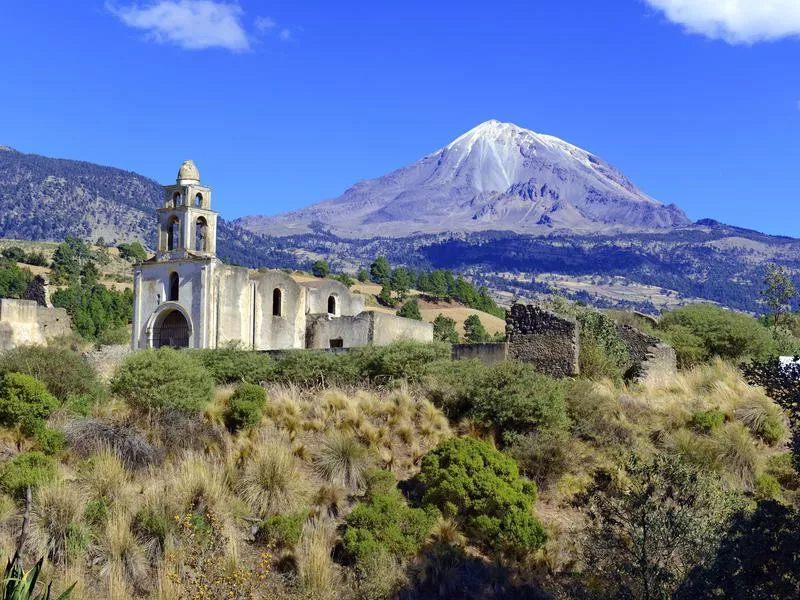
Getty Images
Pico de Orizaba towers over central Mexico. It’s so tall that you could see the summit from the port at Veracruz, about 68 miles away.
The inviting volcano attracts hundreds of climbers each year to reach the summit. It usually takes about 15 hours to ascend with different routes to the top, depending on skill level.
24. Mount Elbrus

Getty Images
What Its Name Means: It’s derived from the Avestan Hara Berezaitil, a legendary mountain in Iranian mythology. It translates to “high watchtower.”
What Sets It Apart
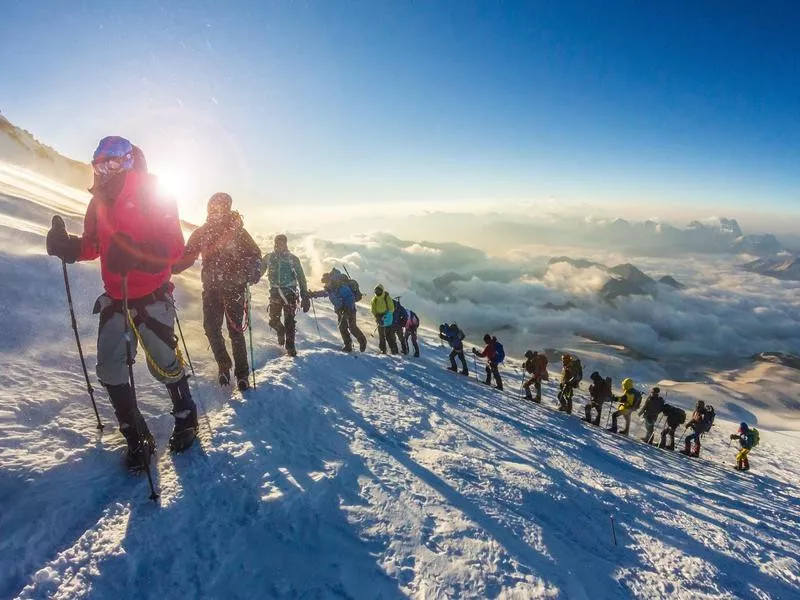
Getty Images
Mount Elbrus is a dormant volcano in southern Russia. While it sits above the clouds, many experienced hikers accept the challenge to summit this magnificent peak. Trekking to the top of Europe’s tallest mountain is extremely demanding, usually involving lack of oxygen, bone-chilling cold and exhaustion.
Once at the top, you better believe that the views are worth it. Depending on the weather, climbers can see the entire Caucasus region or a sea of clouds.
23. Mount Kilimanjaro
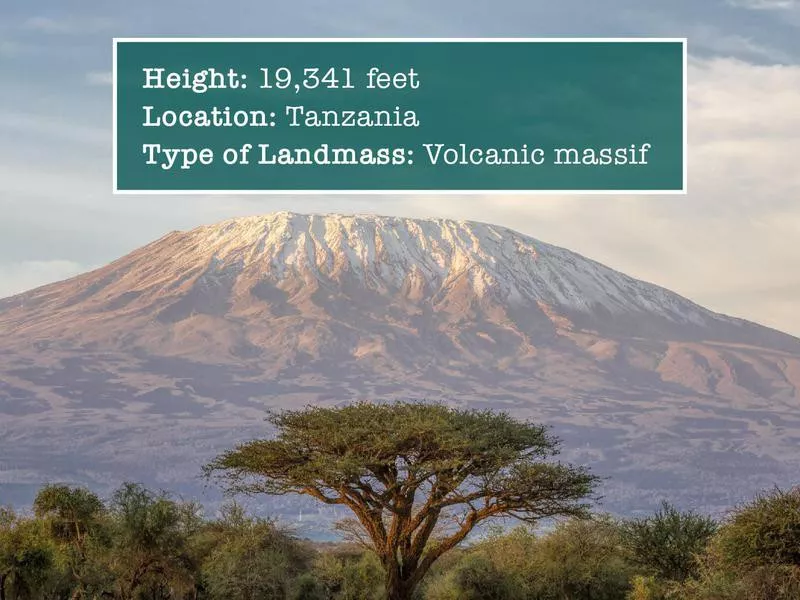
Getty Images
What Its Name Means: Unclear
What Sets It Apart
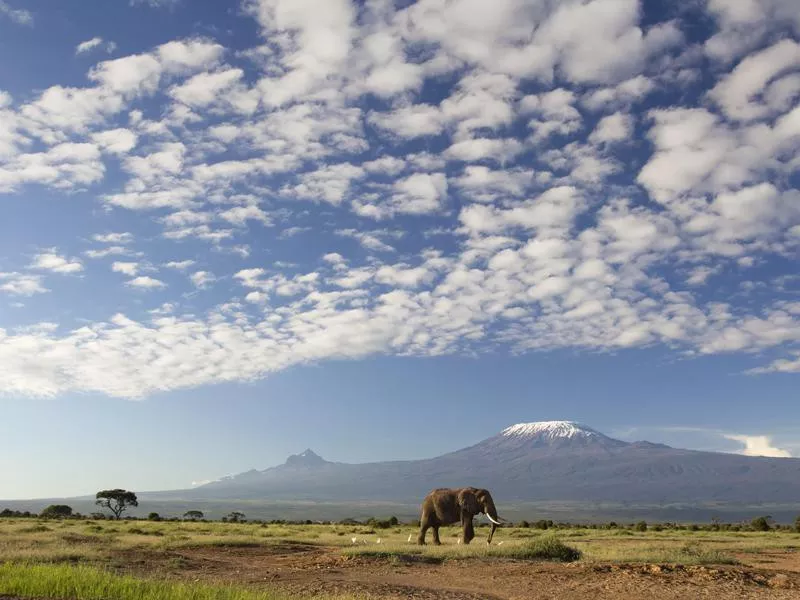
Getty Images
Mount Kilimanjaro is the tallest mountain in Africa. Technically, it’s a volcanic massif that extends 50 miles from east to west. Kilimanjaro attracts thousands of people each year, but not just for climbing!
The surrounding area in Mount Kilimanjaro National Park is a UNESCO World Heritage site. An abundance of habitats surround Kilimanjaro, and the area is home to elephants, buffalo, antelopes and monkeys. It’s an excellent place for spotting wildlife or casual hiking.
22. Mount Logan
What Its Name Means: It’s named after Sir William Edmond Logan, founder of the Geological Survey of Canada.
What Sets It Apart
Mount Logan is the pride of Canadian mountaineering. This monster is the tallest mountain in Canada, located in the Saint Elias Mountain Range. It’s a serious mountain for serious climbers.
Prerequisites include altitude experience of over 14,000 feet, solid glacier travel skills, winter camping experience and excellent physical fitness. Easy, right?! Mount Logan is about 25 miles long and rises 2 miles over its surroundings, so you really can’t miss it.
21. Denali

Getty Images
What Its Name Means: It comes from the native Koyukon Athabaskan word for “high” or “tall.”
What Sets It Apart

Getty Images
Denali is the tallest mountain in North America, and it’s gone through a lot of name changes over the years. It’s been called Denali, Bolshaya Gora, Densmore’s Mountain and Mount McKinley. Denali became its official name in 2015.
No need to take the 17-day journey to the top as there are plenty of tour operators who fly people around the summit. Denali National Park and Preserve is a popular area for ziplining, hiking, camping and wildlife tours.
20. Tres Cruces Centro
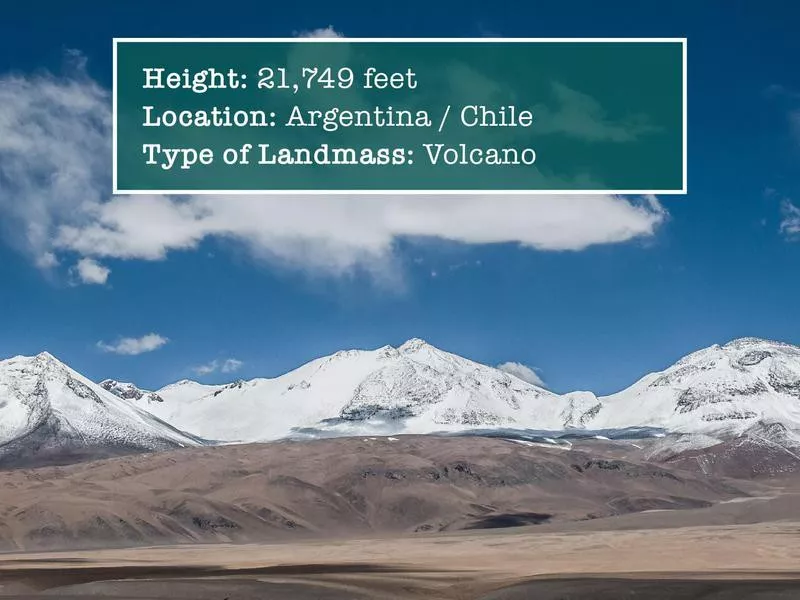
Getty Images
What Its Name Means: It’s Spanish for “three crosses center.”
What Sets It Apart
Tres Cruces Centro lies in a remote area on the border of Argentina and Chile — specifically within the Atacama Desert. It’s not exactly an easy climb, as there are two peaks to conquer.
Extreme weather changes, high altitude and poor accessibility are a few challenges that climbers need to overcome.
19. Cerro Cazadero / Walter Penck
What Its Name Means: It’s Spanish for “hunting site.” It also goes by Walter Penck, the first person to summit it.
What Sets It Apart
Cerro Cazadero also goes by the name Walter Penck, who was the first person to summit this incredible volcano. Cerro Cazadero is located in the Andes in northwest Argentina.
A typical climb takes about 18 days, as this mountaineering adventure needs to be done slowly and steadily due to high altitude. Along the way, climbers encounter stratovolcanoes, lava domes and even lava flows.
18. Cerro Mercedario
What Its Name Means: It’s possibly named for the “Order of the Blessed Virgin Mary of Mercy.”
What Sets It Apart
Cerro Mercedario is located in an isolated and remote area of northwest Argentina. It’s about 60 miles south of Aconcagua (the tallest mountain in South America).
People climb this volcano, although it’s not very popular to do so. There is no crowd, no permit required and no satellite TV at base camp. So, climbers conquer this mountain at their own risk.
17. Llullaillaco
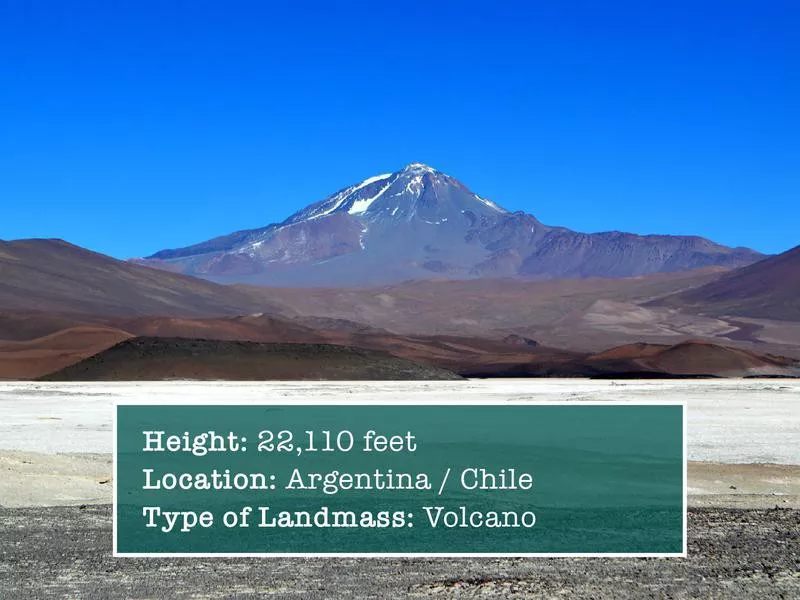
Getty Images
What Its Name Means: It derives from the Quechua word “llulla,” which means “false,” and “yaku,” which means “water” referring to the meltwater that’s absorbed by the soil.
What Sets It Apart
Llullaillaco (say that five times fast) is yet another dormant volcano in a remote area of the Chilean-Argentine border. But this one has a distinct story behind it. Llullaillaco is the tallest archeological site in the world, as the mummies of three Incan children were found at the summit.
Yes, you read that right. Three mummies were discovered on this volcano in 1999. They most likely died as part of a ritual sacrifice 500 years ago. The oldest of the mummies, named La Doncella, is on display at The High Country Archaeological Museum in Salta, Argentina.
16. Nevado Tres Cruces Sur

Getty Images
What Its Name Means: It’s Spanish for “snowy three crosses south.”
What Sets It Apart
Nevado Tres Cruces Sur is different from its similarly named Tres Cruces Centro cousin that lies in the same area. While it’s not a popular climb, it is the highlight of the landscape within the Nevado Tres Cruces National Park.
During the Southern Hemisphere summer, more than 800 birds, including the Andean flamingo and the Chilean flamingo, migrate here each year. There are also plenty of foxes, vicuñas, pumas and condors in the area.
15. Cerro Bonete Chico
What Its Name Means: It’s Spanish for “small hat.”
What Sets It Apart
There are four Cerro Bonetes within Argentina (must be a popular name or something). But the one we’re talking about is the fifth tallest mountain in South America. Of course, it lies in a remote area of northwest Argentina.
Bonete Chico is a massive volcano at the base and then gets narrow as it forms the peak (hence the name “small hat”). Harsh and scarce conditions make this a strategic and challenging climb for mountaineer professionals. It’s in one of the driest areas of the world, so climbers prefer to go during the colder months when it’s easier to find water.
14. Huascaran
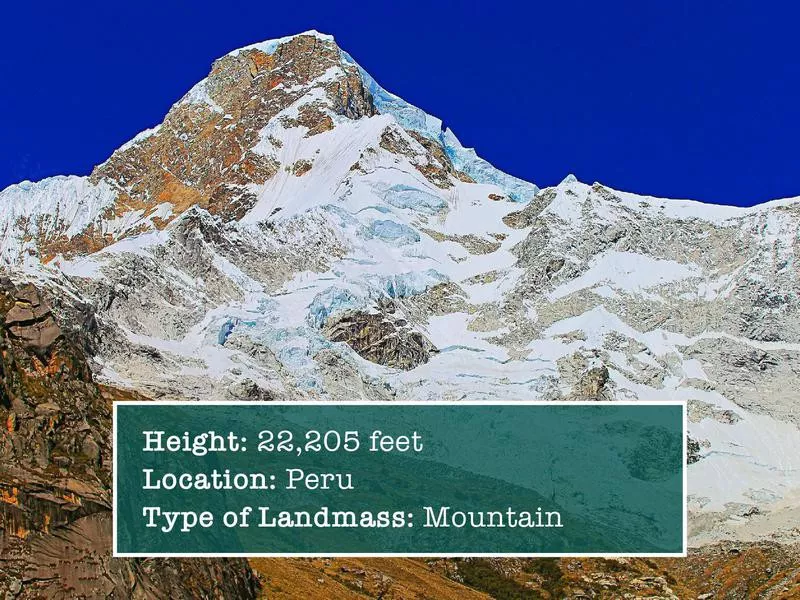
Getty Images
What Its Name Means: It’s named after Huascar, a 16th-century Inca emperor.
What Sets It Apart
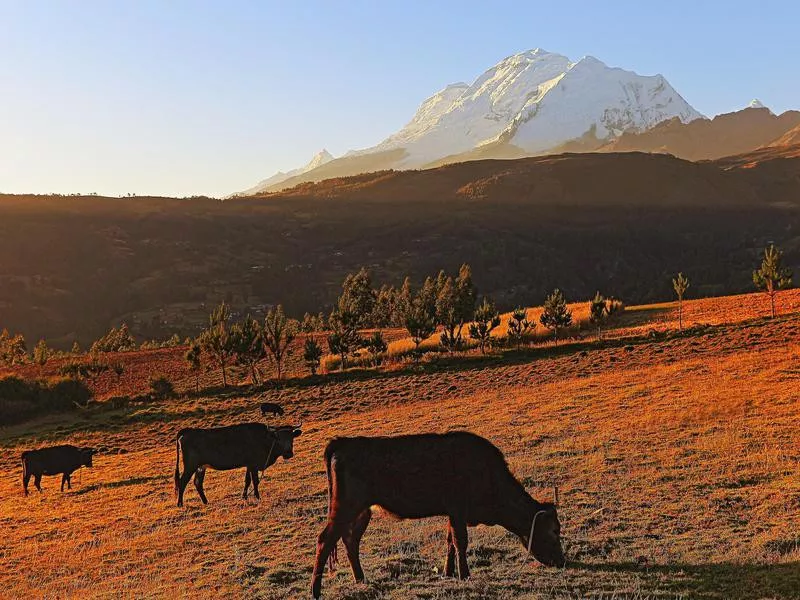
Getty Images
Huascaran is the tallest mountain in the Cordillera Blanco region of Peru. This snow-capped mountain challenges the bravest of climbers. It throws curve balls in weather, altitude, strong winds, icefall and avalanches.
Many people simply enjoy the view of Huascaran on a four-day Santa Cruz trek. This trek navigates through the Cordillera Blanca region with a chance to experience glacial lakes, tall peaks and high altitude. It’s also where you can spot the distinctive Paramount Pictures mountain, Artesonraju.
13. Monte Pissis
What Its Name Means: It’s named after Pedre Jose Amadeo Pissi, a French geologist who worked for the Chilean government.
What Sets It Apart
Monte Pissis is the world’s second tallest volcano. It’s up for debate as to who the first people were to climb it. It’s believed to have been climbed by two famous Polish mountaineers in 1937. But that was brought to question after another group climbed Monte Pissis and didn’t see any of the Poles’ signature markings.
After a mining road opened to the area in 1997, the peak gained more attraction. It’s named after a French geologist who lived from 1812 to 1889, but his exact connection to the mountain is unclear.
12. Ojos del Salado
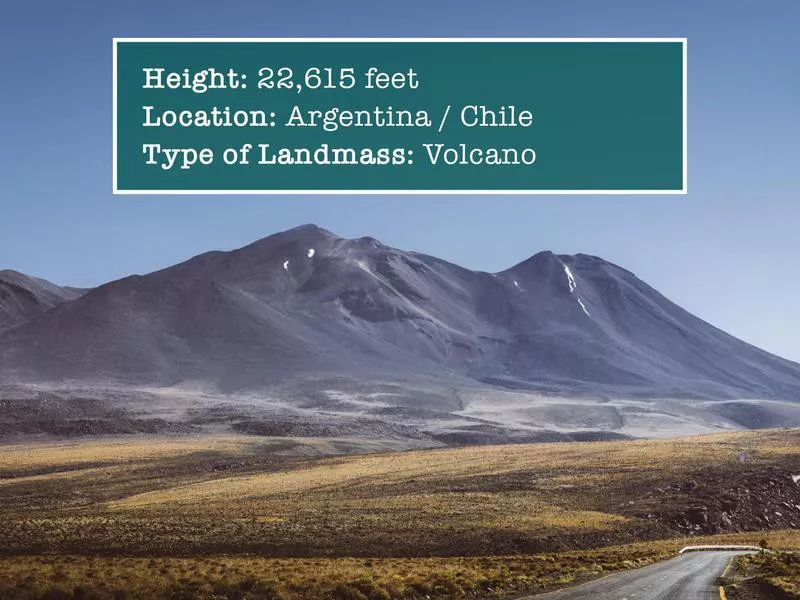
Getty Images
What Its Name Means: It’s Spanish for “eyes of the salty one.”
What Sets It Apart
Ojos del Salado means “eyes of the salty one” and not for a salty attitude but because of the salt deposits within its glaciers. This volcano towers over the Argentina-Chile border. It’s the tallest volcano on Earth, and there is still volcanic activity from its peak.
Because it sits on a border, there are two ways up. Climbers choose between the easy, yet more expensive Chilean side or from the longer but less restrictive Argentinean side. Climbing Ojos del Salado is considered an “easy walk” until people get to the last part, which is a tricky eight-hour rock climb to the top.
11. Aconcagua
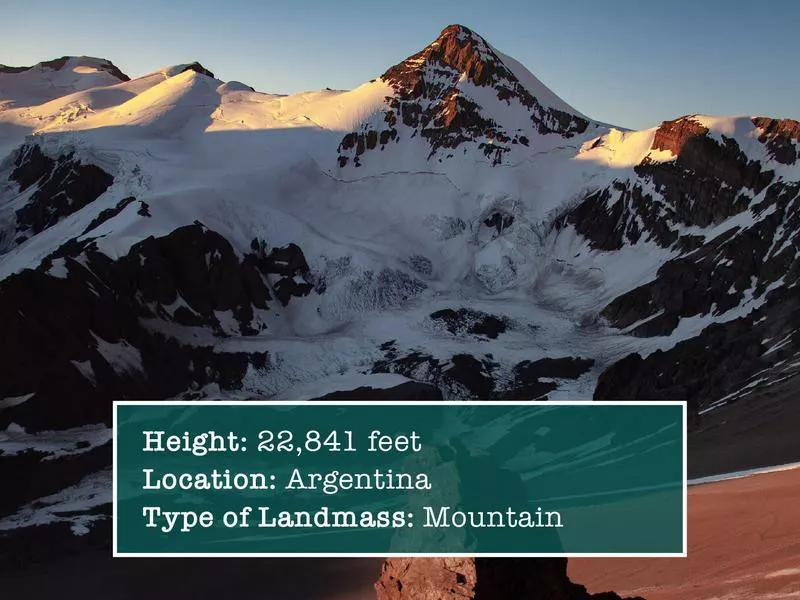
Getty Images
What Its Name Means: It may derive from various native words, meaning “comes from the other side,” “sentinel of stone,” “white sentinel” or “white ravine.”
What Sets It Apart
Aconcagua is the monster of the Southern Hemisphere. She stands 22,800 feet tall and challenges thousands of climbers each year.
The high altitude and extreme weather make it a technical mountain to climb. Aconcagua is located just outside of Mendoza, which most people use as a base to get settled before embarking on the 15- to 18-day trek.
10. Annapurna I
What Its Name Means: It’s named after Annapurna, the Hindu goddess of food and nourishment.
What Sets It Apart
We’re now entering the 8,000-meter club, a mountaineering feat for those determined to stand 8,000 meters (or 26,500 feet) above sea level. Annapurna is not only the Hindu goddess of food and nourishment but also a towering massif in Nepal. It offers a popular trek for individuals and tours, as it’s a steady ascent to the top.
While a climb to the top of Annapurna I is flaked with glacial lakes, snow-capped mountains and wildlife, it’s also known for having some of the best food along the way! The path follows an ancient (and still functioning) trade route, winding its way through local villages. Depending on the route, it’s about a 13- to 17-day trek to the top.
9. Nanga Parbat
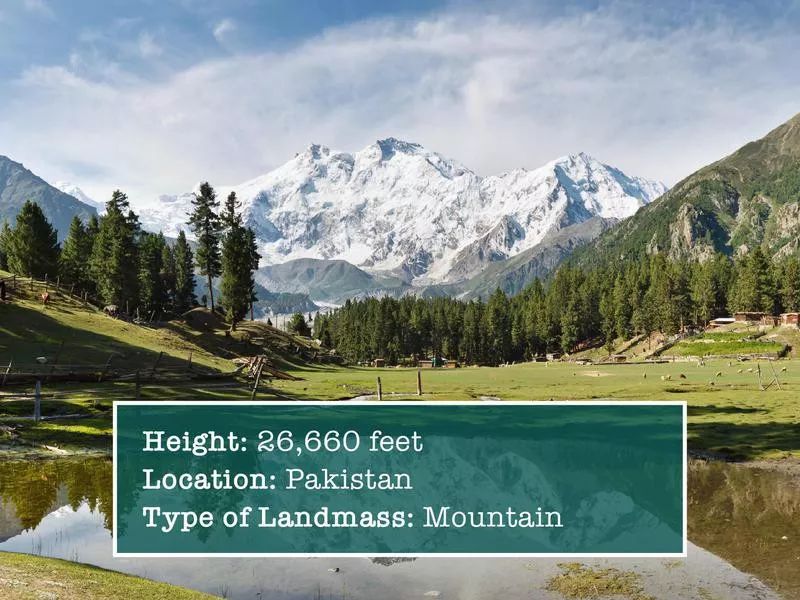
Getty Images
What Its Name Means: It’s from Sanskrit, meaning “naked mountain.”
What Sets It Apart
Nanga Parbat means “naked mountain” in Sanskrit because it lacks snow, but climbers know it as “killer mountain.” It got that nickname after 31 people died attempting to climb this mountain before the first successful ascent in 1953.
Nanga Parbat is prone to avalanches and bad weather. It’s considered the second hardest 8,000-meter peak to conquer. What could be more dangerous than “killer mountain”? Well, keep reading.
8. Manaslu
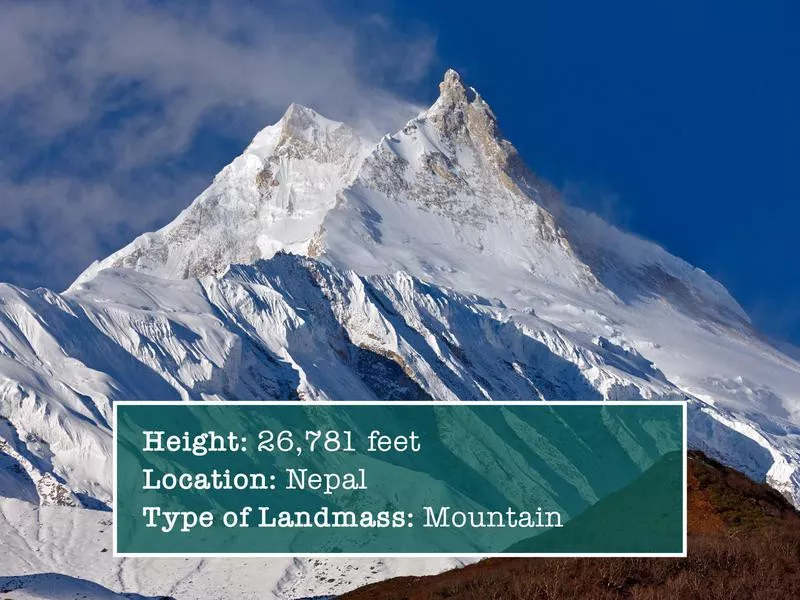
Getty Images
What Its Name Means: It’s Tibetan for “mountain of the spirit,” originating from the Sanskrit word “manasa,” which means “intellect” or “soul.”
What Sets It Apart
Manaslu is a gorgeous mountain in Nepal that takes a casual 42 to 62 days and $10,000 to climb. Erm … yeah. Its remote location, hefty fees and length of the trek make it a less popular mountain to tackle.
Mountaineers start at Kathmandu and trek to Manaslu base camp. From there, they climb up the snowy mountain. This 8,000-meter peak is dangerous, as it’s prone to avalanches. There are 32 recorded avalanche fatalities on Manaslu.
7. Dhaulagiri
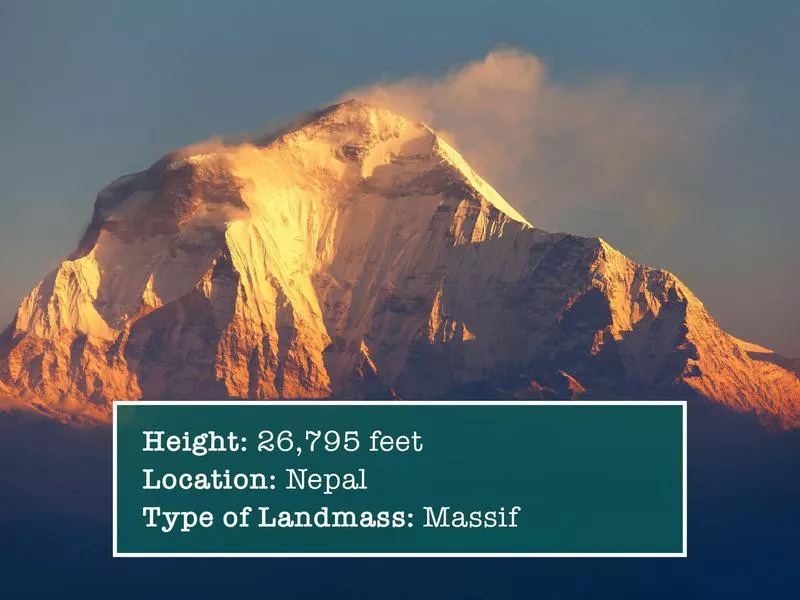
Getty Images
What Its Name Means: It’s Sanskrit, meaning “dazzling white beautiful mountain.”
What Sets It Apart
Dhaulagiri is a dazzling white beautiful mountain, according to the meaning of its name in Sanskrit. It’s located in the Himalayas and rises above the deepest gorge in the world called Kali Gandaki Gorge.
The Himalayan mountain range is dangerous to climbers because of avalanches. As of 2015, about 70 climbers died while attempting to climb Dhaulagiri. A climb to the top takes about 50 days and a very high level of fitness.
6. Cho Oyu
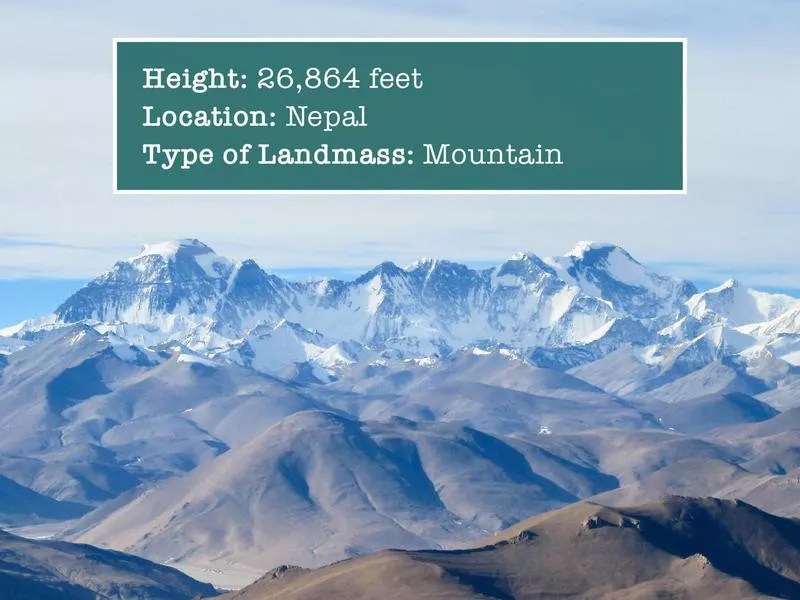
Getty Images
What Its Name Means: It’s “turquoise goddess” in Tibetan.
What Sets It Apart
Cho Oyu means “turquoise goddess” in Tibetan, as she stands tall and mighty in the Himalayan sky. It’s considered one of the easier climbs of the 8,000-meter peaks (that is, of course, the opinion among experienced mountaineers).
Climbers use Cho Oyu as a practice run before conquering the top five tallest mountains on this list. Although, they’ll have to shell out $30,000 before reaching the top.
5. Makalu
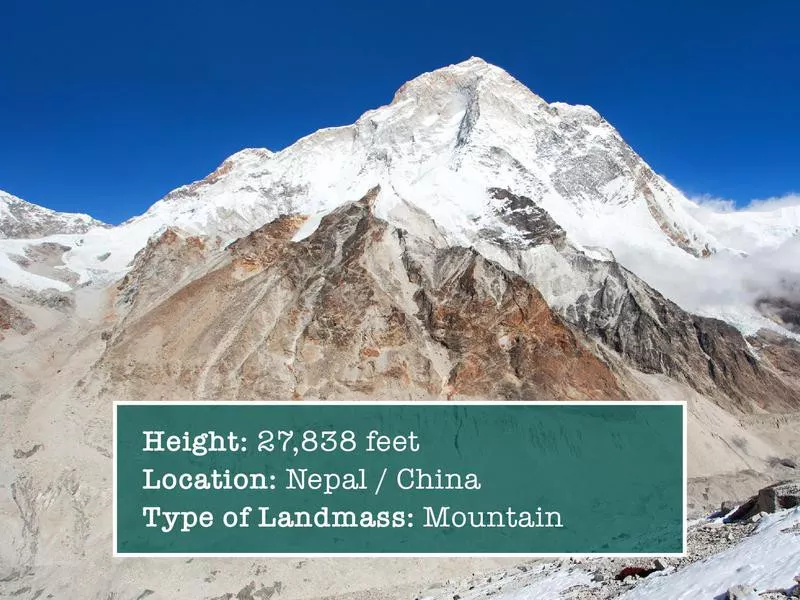
Getty Images
What Its Name Means: In Sanskrit, it means “big black,” the name for the Hindu god Shiva.
What Sets It Apart
A successful climb to the top of Makalu is rare, as there have been fewer than 300 recorded attempts to climb it since 1955. And that doesn’t mean they made it to the top.
Makalu has a steep, icy peak that makes it exceptionally challenging for experienced climbers. It can take up to 2.5 months to complete (if successful). The daunting mountain often gets overshadowed by its famous neighbor, Mount Everest.
4. Lhotse
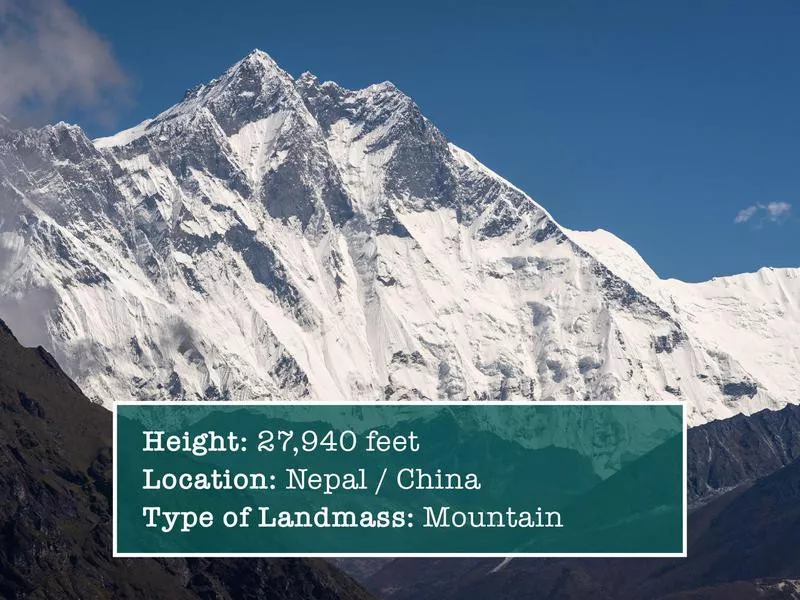
Getty Images
What Its Name Means: It’s Tibetan for “south peak.”
What Sets It Apart
“The other Everest,” as it’s so often called, is the south peak of the Everest massif. Lhoste is in no way a lesser peak; it takes technical skills, high fitness and preparation.
It costs half as much to climb but the same amount of time as Everest. And from the top, people get an incredible view of the tallest mountain in the world.
3. Kangchenjunga
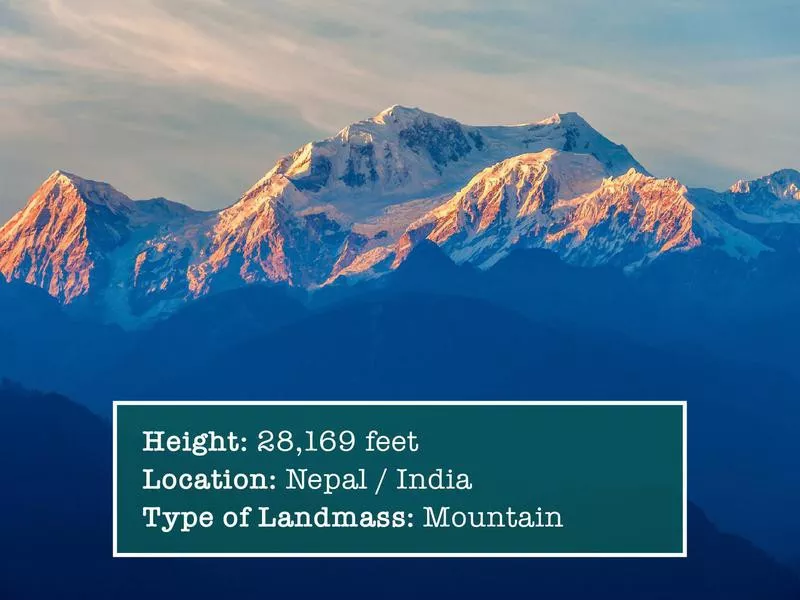
Getty Images
What Its Name Means: It translates to “the five treasures of the high snow.” Local Lhopo people believe the treasures are hidden but will be revealed to the devout when the world is in peril.
What Sets It Apart
Kangchenjunga lies on the border of Nepal and India. The third tallest mountain in the world has five peaks that represent the five repositories of God — gold, silver, gems, grain and holy books (as per the Tibetan meaning “five treasures of the high snow”).
Kanchenjunga has a fatality rate of 15 percent, as it’s a dangerous one to climb. A great way to experience this mountain without a potentially fatal climb is a view of this beauty from Tiger Hill at sunrise.
2. K2

Getty Images
What Its Name Means: During the first survey of the Karakoram range, the surveyor labeled each mountain with a “K” and a number. It did not have a local name due to its remoteness — it was not visible from any surrounding villages.
What Sets It Apart
Remember how “killer mountain” wasn’t the most difficult mountain to climb? That’s because K2 takes the crown for that title. It’s located in a remote area of Pakistan and is known for being impossible to conquer among climbers. It’s almost-vertical peak requires a technical climb to the top.
K2, aka “savage mountain,” is only meant to be climbed by hardcore mountaineers, while Mount Everest attracts a crowd of amateur climbers. It’s the only 8,000-meter peak that hasn’t been climbed during the winter.
1. Mount Everest
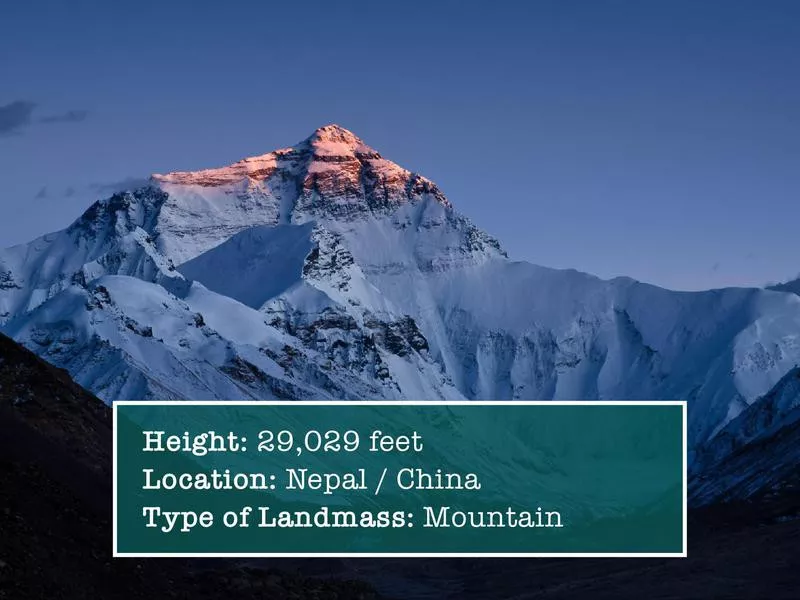
Getty Images
What Its Name Means: It’s named after Sir George Everest, former surveyor general of India, who protested the name. Its Nepali name means “forehead of the sky,” and its Tibetan name means “goddess mother of mountains.”
What Sets It Apart
The Queen of the tallest mountains in the world is Mount Everest. (Her Tibetan name means “goddess mother of mountains,” so that’s how we know she’s a queen.) Although there’s controversy over the height of the summit, Mount Everest stands 29,029-feet tall. And she grows about 4 millimeters in height every year!
Because of her title as the highest peak in the world, Mount Everest attracts thousands of people each year. Everest is getting so crowded that people are dying, not from avalanches, but from waiting in line to take a picture at the summit. The Everest base camp even has Wi-Fi to accommodate a growing number of climbers. Before that, a satellite phone was available for a hefty $600 to $1,000.